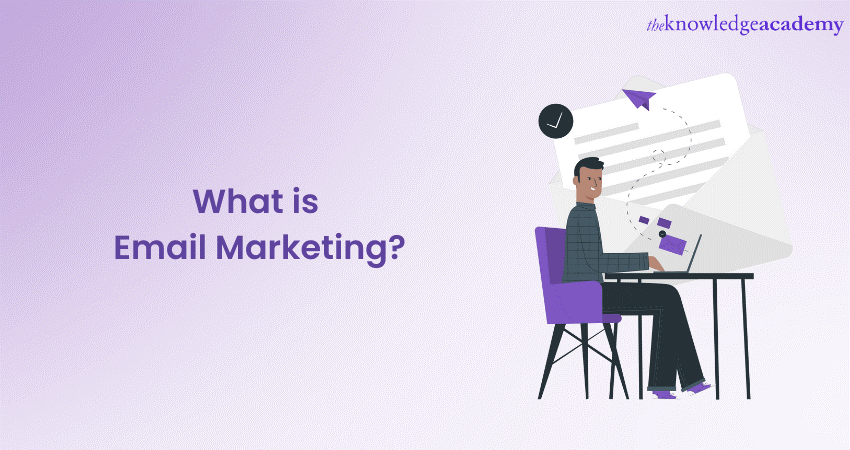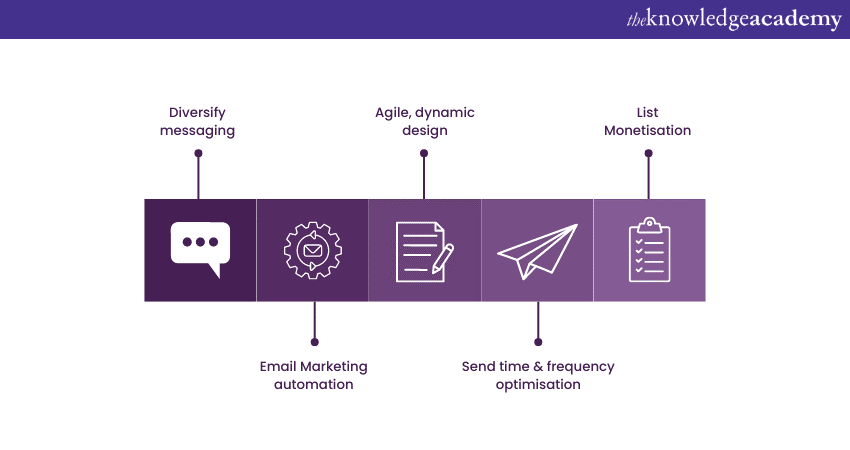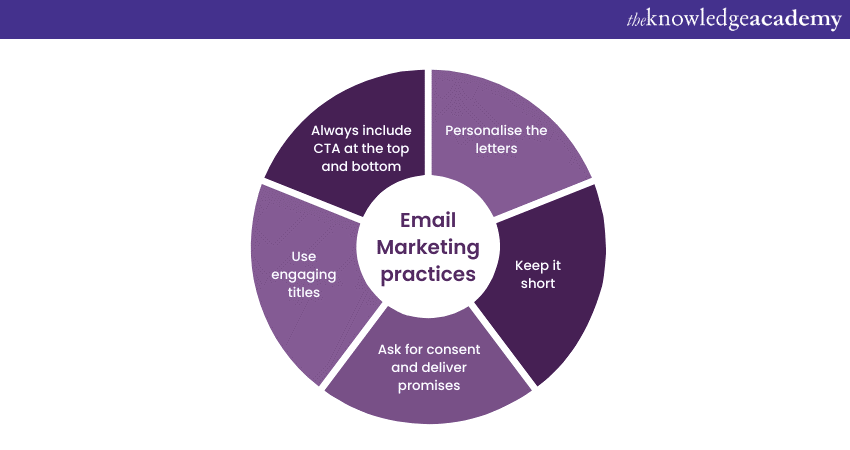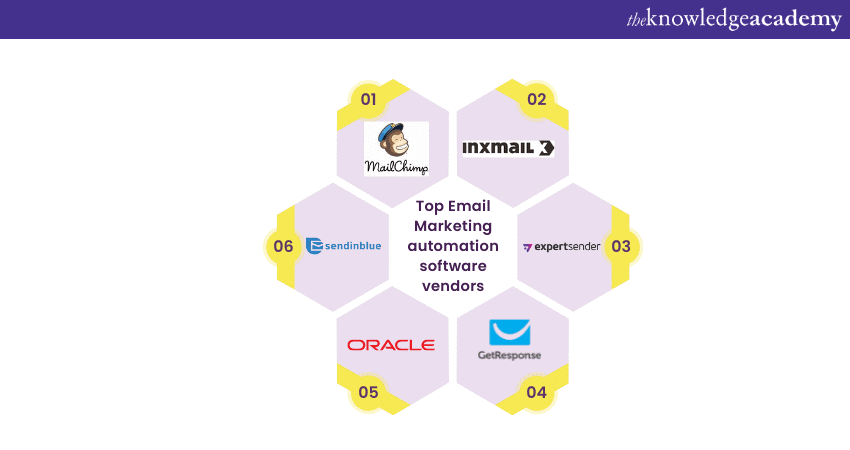We may not have the course you’re looking for. If you enquire or give us a call on 01344203999 and speak to our training experts, we may still be able to help with your training requirements.
Training Outcomes Within Your Budget!
We ensure quality, budget-alignment, and timely delivery by our expert instructors.

Email is a great communication channel to connect with people all over the world. As a communication channel, it is also widely used to promote products and services. It can help gain the necessary feedback from loyal customers while bringing new ones. But is it even useful to know What is Email Marketing when we have other communication channels like Social Media , and Website Blogs?
According to Statista, in 2020, there were four billion global email users, and this number is projected to increase to 4.6 billion users by 2025. Such factors are responsible for higher ROI value. Email Marketing has a much higher ROI than other marketing channels like Social Media and Paid Search. In this blog, we will discuss What is Email Marketing, its relevancy and how a brand can implement it to strengthen its community.
Table of Contents
1) What is Email Marketing?
2) Foundations and principles of Email Marketing
3) Types of Email Marketing
4) How to write a Marketing Email?
5) Best Practices of Email Marketing
6) Deliverability Rate, ISP and ESP
7) Benefits of Email Marketing
8) Conclusion
What is Email Marketing?
Emails that we subscribe to like newsletters and milestone emails come under Marketing Emails. To understand it further let’s understand the meaning of Sales Funnel. Sales Funnel is a journey that a potential customer takes from becoming a prospect to purchasing the service. A Marketing Email is designed to send the prospect down this Sales Funnel. These emails can only be sent to the people who has subscribed to that content.
Marketing on Social Media seems like the correct move in this environment, but it comes with many downsides. Firstly, marketing on Social Media comes with a fear of negative feedback and damaging brands’ name. On social media, some individuals aim to tarnish others' reputations. It's vital for users to discern truth from falsehood and prevent the spread of damaging information.
Marketing products and services via email can strengthen long-term customer relationships. Many companies and businesses have successfully built communities around their brand because they understand the significance of Email Marketing.

Have you ever received an email that informs you about a job offer? That same email must have been sent to other candidates too through Mass Mailing. Mass Mailing is a way of communicating to a large group of people by sending them the same information. A decade ago, these mails used to have one-size-fits-all format. But today, the focus of Email Marketing mainly depends upon personalising the mail by dividing it into segments. Email marketing can initially seem time-consuming. However, an effective strategy can boost sales and offer a high return on investment.
Do you want to stablish a brand and increase your sales? Register for our Marketing Training and beat the competition!
Foundations and principles of Email Marketing
Email marketing, at its core, revolves around directly connecting with prospects and customers via electronic mail. To achieve success and foster meaningful connections, one needs to understand the foundational elements and guiding principles that govern this form of marketing.
Permission-based Marketing:
The foundation of any email marketing effort rests on gaining explicit permission from recipients. This ensures that your emails are not viewed as spam. Common ways to obtain permission include opt-in forms, subscription sign-ups, or through previous business interactions.
Targeting and segmentation:
Understanding and categorising your audience helps in delivering relevant content. Segmentation can be based on demographics, behaviour, purchasing history, or engagement levels. This ensures that the right message reaches the right person at the right time.
Value proposition:
Each email should offer some form of value to the recipient. This could be in the form of information, offers, insights, or even entertainment. A clear and compelling value proposition encourages higher engagement rates.
Types of Email Marketing
Email Marketing meaning has changed drastically since 1978, when it first started. Emails are divided into several types which are mentioned below.
Promotional Emails
Many receive emails about latest offers, new product releases, or upcoming webinars. Those types of emails come under the umbrella of Promotional Emails. The focus of these emails is to grow your brand’s community by gaining more subscribers. A campaign consists of 4-10 emails that an Email Marketing team sends over for several weeks or days. Generally, there is a campaign to deliver such emails.
Promotional Emails are designed for a user to act on Call-to-Actions (CTA). CTA enables the user to take an action immediately. Most of the times CTA takes a user to a company’s website where they can browse and shop if they find something useful.
It is very important to send Promotional Emails multiple times during days like Christmas, Black Friday, and Easter. This is the time when most brands are looking to increase their community by offering services at low prices. A business can grow exponentially if it uses this technique efficiently. Although sending Marketing Emails is efficient most of the time, there are periods on Marketing Callender that indicate months with low sales. A brand can increase cost efficiency by not delivering Promotional Emails for those times.
Informational Emails
As the name suggests, Informational Emails are used widely to deliver important news and announcement about a brand. It is divided into two categories: Newsletters and announcements.
A brand sends newsletters whenever they need to share important ideas, like their vision and celebration of accomplishing a milestone. The work of a newsletter is to offer guidance and useful information to consumers. Newsletters that include useful tips also help in building a deeper connection with the reader. Consistency is the key to gaining an audience through these emails. It can be sent weekly or monthly, based on brand consumption and product type.
Announcements, on the other hand, are used to inform the audience about important issues like glitches on the company’s website, shipping delays and so on. It is also widely used to inform the audience about a new product or service. Announcements can also be used to inform about the delays that might occur in the shipping of a product or when the company’s website is inaccessible.
Re-engagement emails
Re-engagement emails are designed to re-engage a lost consumer or an audience that is no longer active. These letters can ask for feedback, insights and offer something better to bring the person back. Many shopping applications and food delivery applications use re-engagement emails to bring back consumers by showing the benefits of using their services.

How to write a Marketing Email?
Writing a marketing email can be daunting for beginners. For those new to it or missing key points, consider the following steps:
1) Strategy planning: The first step towards having a good strategy would be noting down initial goals. For beginners, it is important to distinguish the type of product they are selling to understand how they should market it.
2) Designing a marketing email: As a beginner, the technical aspect of designing a marketing email might seem challenging. But through drag-and-drop editors, creating professional marketing designs has never been easier. Although a variety of exceptional marketing campaign designs can be found by doing research, keeping the designs simple will also work.
3) Use of existing templates: There is no need to sit for hours and design a template that stands out. Many available templates can make email marketing designs stand out.
Having trouble starting your journey with Digital Marketing? Register to our Digital Email Marketing Masterclass and learn the essence of Digital Marketing.
Best practices of Email Marketing

Apart from sending emails, it is also based on understanding the nuances of sending an email to gain more subscribers. Let us have a look at some fundamentals that can help:
1) Personalise the emails: It is very important understand the importance of personalisation. If it feels like they are just reading some randomly generated text, they won’t participate in the process. Use a name, try using their name at least once, and be open about a service to show them the human side.
2) Keep it short: No one has time or even likes reading long paragraphs about a service that appears out of nowhere. Keeping the notes short and quickly delivering the message will keep the reader engaged. Otherwise, one will lose them after a while.
3) Ask for consent and deliver promises: We have already discussed above the need of consent of an audience to make them subscriber. Sending emails to people without their consent can result in bad return on investment (ROI). It is even illegal in some countries like Canada and US to send information without the permission of the user. Once we get their consent, always deliver the things that we promised. This will help us keep the readers engaged.
4) Use engaging titles: Using engaging titles intrigues the reader to at least glance at the email, even if they are not going to read it properly. Titles can have a deep impact on a person’s psychology and influence their decisions. Using engaging titles is important, but using them as bait can also have a negative impact on audience. Try not using titles as bait and then switching them to something else.
5) Always include CTAs at the top and bottom: Finding CTAs is obvious if someone comes across a landing page. The same goes for Email Marketing. If we bring a strong CTA after a good introduction and after a satisfying conclusion, we see significant improvement in responses from the audience.
Deliverability rate, ISP and ESP
Deliverability rate can be defined as the rate by which emails are delivered to the intended receiver. It avoids the spam folder. Marketing emails have a higher bandwidth, better design and email deliverability. If we just start sending emails through a regular inbox (like Gmail and Yahoo), we won’t receive much or any click-through-rate (CTR) most of the times.
Additionally, Internet Service Providers (ISP) designed their services for personal use. If someone bombarding marketing emails through these ISPs, it might consider them spam and put all their emails in the spam folder. Due to this, account might also get disabled through such activities. Meanwhile Email Service Providers (ESP) deal with software that manages the entire marketing campaign. They have a wide variety of designs and bandwidth to deliver emails in masses, and they also manage excellent deliverability rates.

Steps to find the right ESP
ESP is the first step to building a strong Email Marketing campaign efficiently. But where do we find an efficient ESP? Here are a few parameters that can help us find just the right ESP:
1) First, let’s start with the budget. If someone has a low budget, starting with a cheap service provider can be their solution.
2) The second thing to consider is the number of people in the audience and how often one is planning to send emails. One should also consider making a list of contacts if they already have one.
3) Finding the right email design is very important to impact the interest of the leader. Some people prefer writing code emails with the help of HTML editor, while others prefer using email templates or email editor.
4) It is very important to have an understanding of demographic. This will help a person make an efficient model. While choosing ESP that will fulfil their needs, they can go through their contact list generation capabilities.
5) If emails are going to be transactional (order confirmation, password reset), find the ESP that offers Transactional Emails with marketing emails.
Having tough time with finding the perfect email structure? Register to our Email Marketing Course.
Benefits of Email Marketing
Most successful brand in the world understand the importance of Email marketing. To examine it further, let us discuss a few benefits below:
Drive traffic on web pages and social media
Connections are built on trust and transparency. Emails help service providers gain trust and transparency. Once a brand establishes trust, Email Marketing can be used to drive the traffic to websites, blogs and social media.
By understanding the value of Email Segmentation, one can also target specific group of people that will read their blogs. Email Segmentation is a process of dividing email subscribers into segments (similar group of audience). This division can be based on age, gender, geography, and so on.
Personalisation
When we talk to people individually, rather than thinking of them as a group, we build personalised connections. Personalising an email gives us an advantage of impacting an individual directly. Sending email subscribers special personalised Emails on their birthdays and anniversary can build a genuine connection.
One also regains a lost subscriber if they try reaching out to people by personalising emails. Asking their feedback to win them back and emailing them specifically with a new offer are ways to personalise emails.
Brand awareness
If a brand keeps on showing up in a person’s inbox, it is going to stay fresh and current in their mind. This is a very powerful tool to maintain brand image. People do not like to add just any brand to their inbox these days, which means if brand gets an access to their inbox, they want to know more about brand.
One of the biggest advantage Email Marketing has over other channels is being cost-effective. One can send emails to large number of audiences with minimum cost.
Gain customer loyalty
Customer loyalty is one of the toughest milestones to achieve for any company. Gaining customer loyalty from someone is very important because they will come back again and won’t mind a few errors. Email Marketing brings us closer to this milestone.
On a stage of lead-nurturing, emails can help us gather necessary follow-ups. And if a consumer is having second thoughts about a service, emails help keep them updated and gather feedbacks. One can also retain lost consumers and regain their loyalty through powerful Email Marketing.
Conclusion
Understanding What is Email Marketing, offers the chance to grow a brand. In today’s world, connecting with audience and consumers is very important. A devoted patron not only returns repeatedly but also shows understanding for occasional errors made during the journey. When a brand consistently employs Email Marketing, there are no bounds to its potential.
Learn to organise marketing strategies and build strong responses to the delays. Register to our Business Marketing Strategies Training.
Frequently Asked Questions
Upcoming Digital Marketing Resources Batches & Dates
Date
 Email Marketing Course
Email Marketing Course
Fri 23rd Aug 2024
Fri 6th Dec 2024







 Top Rated Course
Top Rated Course


 If you wish to make any changes to your course, please
If you wish to make any changes to your course, please


